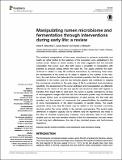Por favor, use este identificador para citar o enlazar a este item:
http://hdl.handle.net/10261/152904COMPARTIR / EXPORTAR:
 SHARE SHARE
 CORE
BASE CORE
BASE
|
|
| Visualizar otros formatos: MARC | Dublin Core | RDF | ORE | MODS | METS | DIDL | DATACITE | |

| Campo DC | Valor | Lengua/Idioma |
|---|---|---|
| dc.contributor.author | Yáñez Ruiz, David R. | - |
| dc.contributor.author | Abecia, Leticia | - |
| dc.contributor.author | Newbold, C. Jamie | - |
| dc.date.accessioned | 2017-07-14T11:21:08Z | - |
| dc.date.available | 2017-07-14T11:21:08Z | - |
| dc.date.issued | 2015-10-14 | - |
| dc.identifier.citation | Frontiers in Microbiology 6: 1133 (2015) | - |
| dc.identifier.issn | 1664-302X | - |
| dc.identifier.uri | http://hdl.handle.net/10261/152904 | - |
| dc.description.abstract | The nutritional manipulations of the rumen microbiome to enhance productivity and health are rather limited by the resilience of the ecosystem once established in the mature rumen. Based on recent studies, it has been suggested that the microbial colonization that occurs soon after birth opens a possibility of manipulation with potential to produce lasting effects into adult life. This paper presents the state-of-the-art in relation to early life nutritional interventions by addressing three areas: the development of the rumen as an organ in regards to the nutrition of the new-born, the main factors that determine the microbial population that first colonizes and establishes in the rumen, and the key immunity players that contribute to shaping the commensal microbiota in the early stage of life to understand host-microbiome specificity. The development of the rumen epithelium and muscularization are differently affected by the nature of the diet and special care should be taken with regards to transition from liquid (milk) to solid feed. The rumen is quickly colonized by all type of microorganisms straight after birth and the colonization pattern may be influenced by several factors such as presence/absence of adult animals, the first solid diet provided, and the inclusion of compounds that prevent/facilitate the establishment of some microorganisms or the direct inoculation of specific strains. The results presented show how early life events may be related to the microbial community structure and/or the rumen activity in the animals post-weaning. This would create differences in adaptive capacity due to different early life experiences and leads to the idea of microbial programming. However, many elements need to be further studied such as: the most sensitive window of time for interventions, the best means to test long term effectiveness, the role of key microbial groups and host-immune regulations. | - |
| dc.description.sponsorship | This work is part of the FACCE-JPI project ‘RumenStability’ funded by INIA and DEFRA in Spain and UK, respectively. CN acknowledges the support of the Biotechnology and Biological Sciences Research Council, UK via grant number BB/J0013/1. DY-R acknowledges support from CSIC (Proyecto Intramural 201440E048) and from MINECO (grant BFU2014-57964-R). | - |
| dc.publisher | Frontiers Media | - |
| dc.relation | info:eu-repo/grantAgreement/MINECO/Plan Estatal de Investigación Científica y Técnica y de Innovación 2013-2016MINECO/ICTI2013‐2016/BFU2014-57964-R | - |
| dc.relation.isversionof | Publisher's version | - |
| dc.rights | openAccess | - |
| dc.title | Manipulating rumen microbiome and fermentation through interventions during early life: a review | - |
| dc.type | artículo | - |
| dc.identifier.doi | 10.3389/fmicb.2015.01133 | - |
| dc.description.peerreviewed | Peer reviewed | - |
| dc.relation.publisherversion | http://dx.doi.org/10.3389/fmicb.2015.01133 | - |
| dc.date.updated | 2017-07-14T11:21:08Z | - |
| dc.description.version | Peer Reviewed | - |
| dc.language.rfc3066 | en | - |
| dc.rights.holder | Copyright © 2015 Yáñez-Ruiz, Abecia and Newbold. | - |
| dc.rights.license | http://creativecommons.org/licenses/by/4.0/ | - |
| dc.contributor.funder | CSIC - Instituto Nacional de Investigación y Tecnología Agraria y Alimentaria (INIA) | - |
| dc.contributor.funder | Ministry of Agriculture, Fisheries and Food (UK) | - |
| dc.contributor.funder | Ministerio de Economía y Competitividad (España) | - |
| dc.relation.csic | Sí | - |
| dc.identifier.funder | http://dx.doi.org/10.13039/501100003329 | es_ES |
| dc.identifier.funder | http://dx.doi.org/10.13039/100007652 | es_ES |
| dc.identifier.pmid | 26528276 | - |
| dc.type.coar | http://purl.org/coar/resource_type/c_6501 | es_ES |
| item.cerifentitytype | Publications | - |
| item.openairecristype | http://purl.org/coar/resource_type/c_18cf | - |
| item.grantfulltext | open | - |
| item.openairetype | artículo | - |
| item.fulltext | With Fulltext | - |
| Aparece en las colecciones: | (EEZ) Artículos | |
Ficheros en este ítem:
| Fichero | Descripción | Tamaño | Formato | |
|---|---|---|---|---|
| Manipulating rumen microbiome and fermentation.pdf | 705,64 kB | Adobe PDF |  Visualizar/Abrir |
CORE Recommender
PubMed Central
Citations
116
checked on 29-abr-2024
SCOPUSTM
Citations
227
checked on 01-may-2024
WEB OF SCIENCETM
Citations
206
checked on 24-feb-2024
Page view(s)
294
checked on 06-may-2024
Download(s)
274
checked on 06-may-2024

